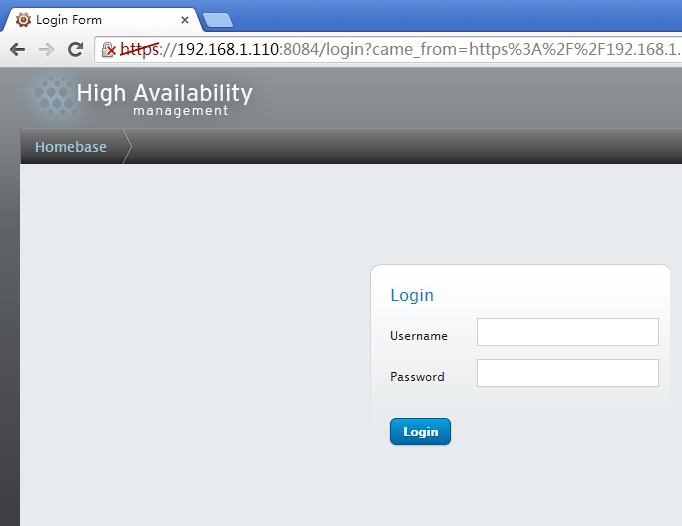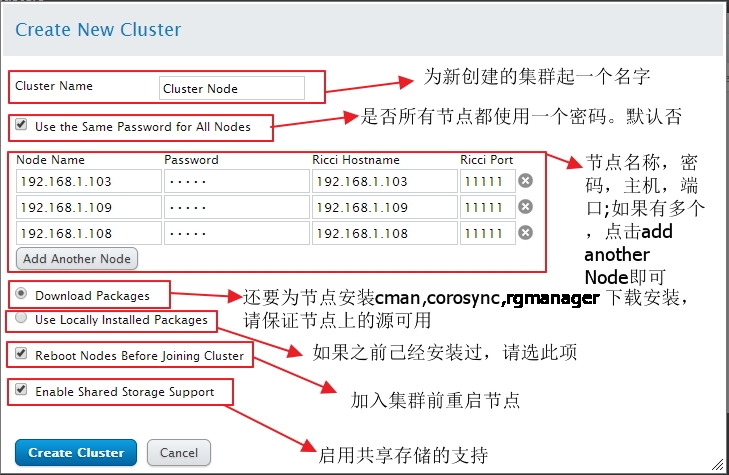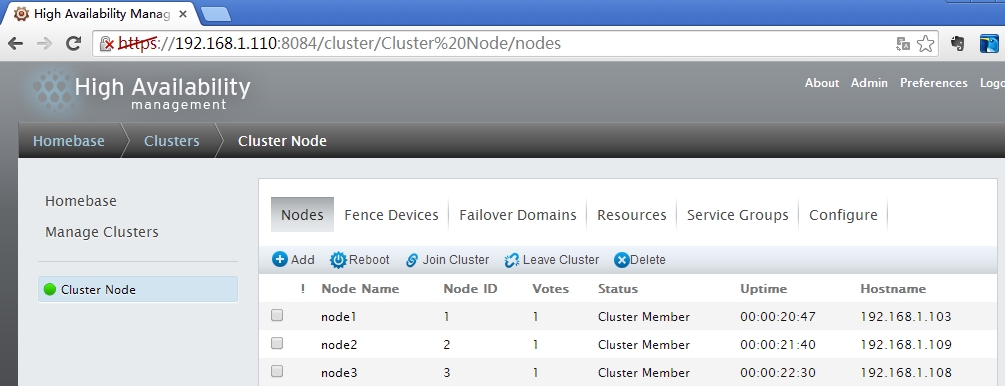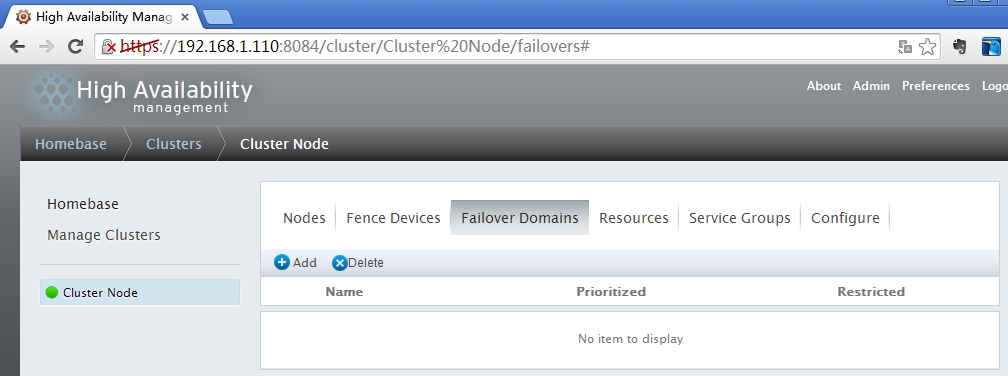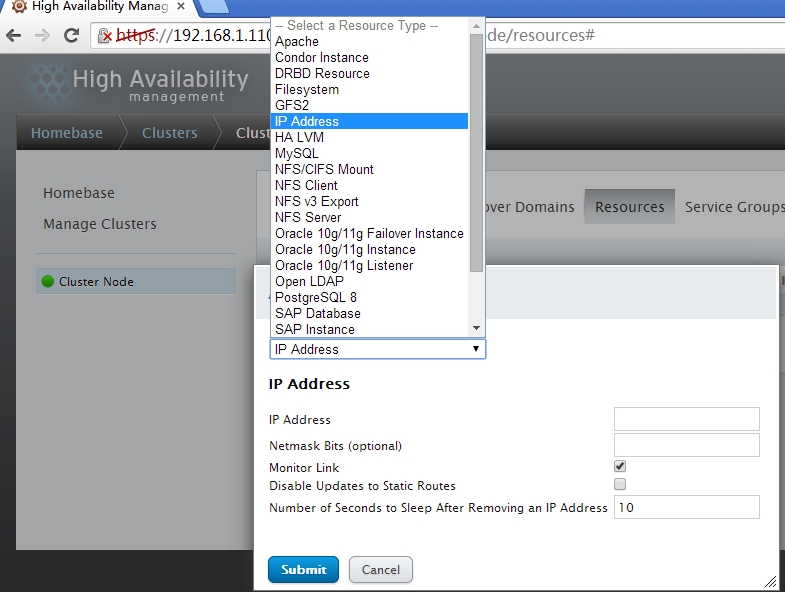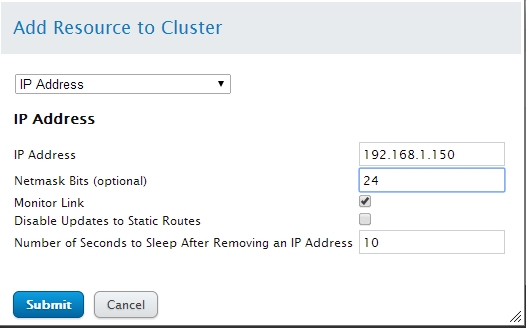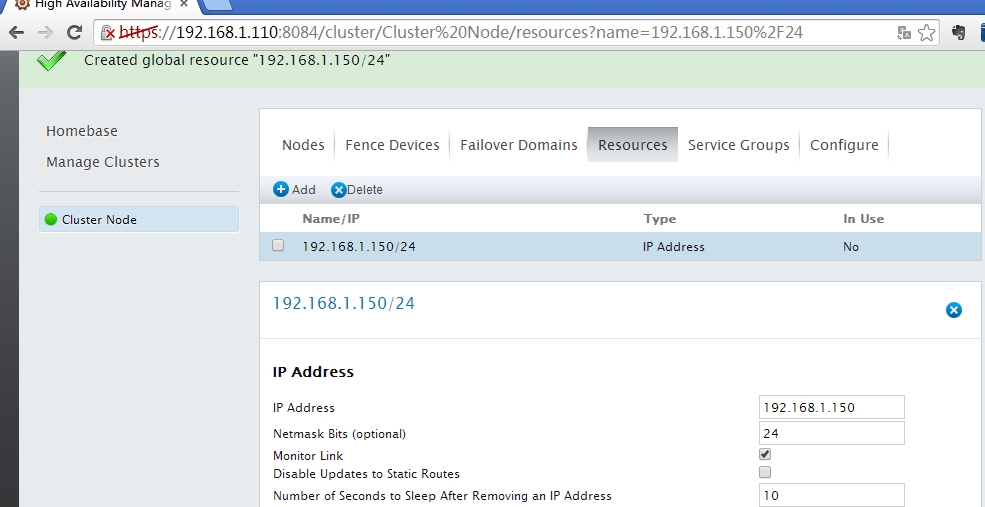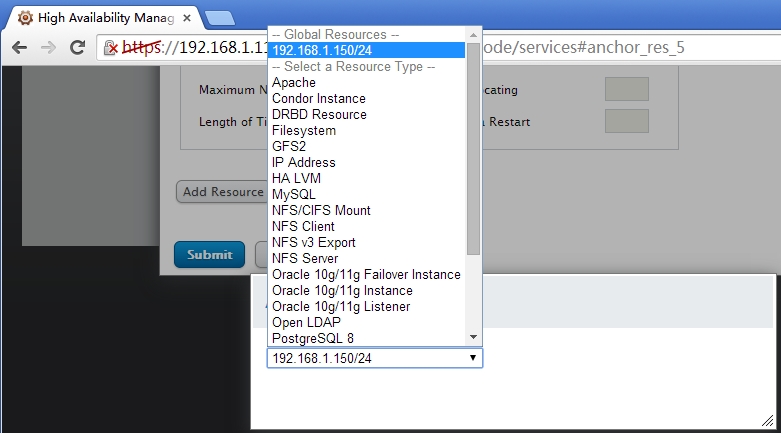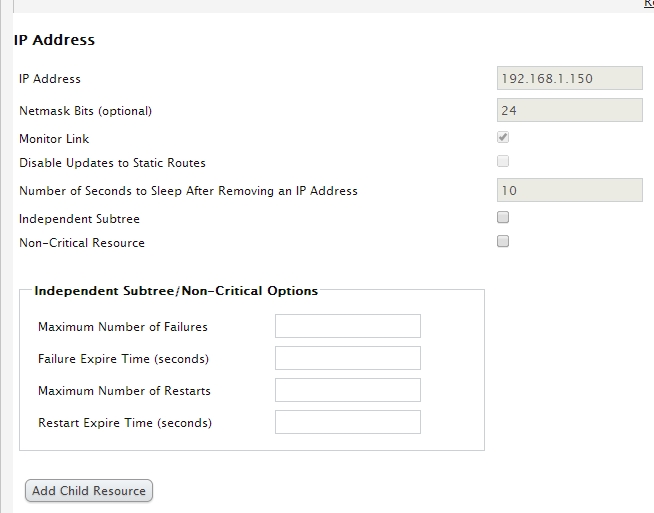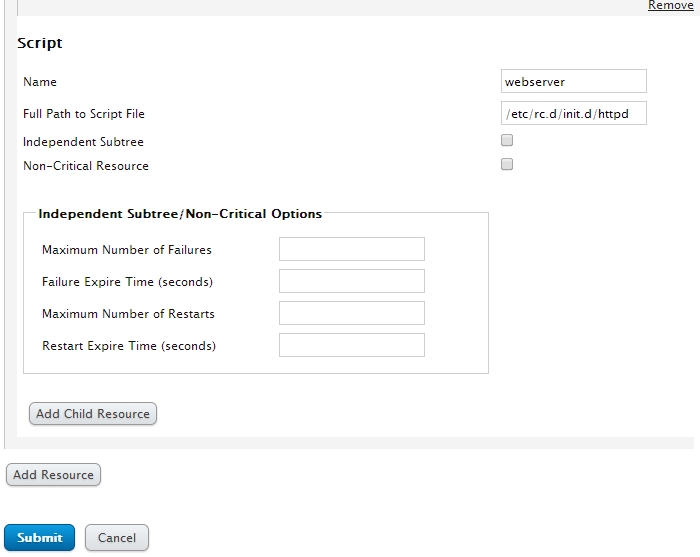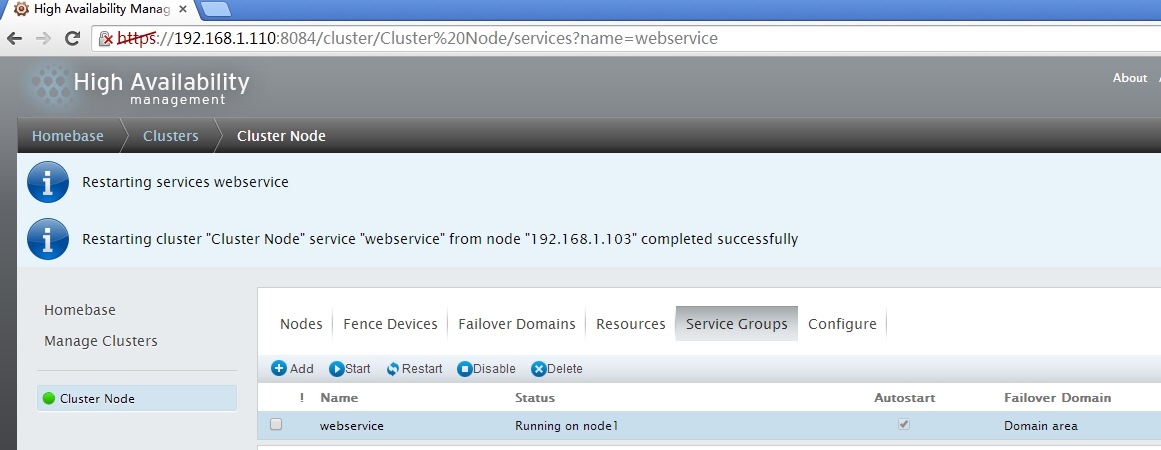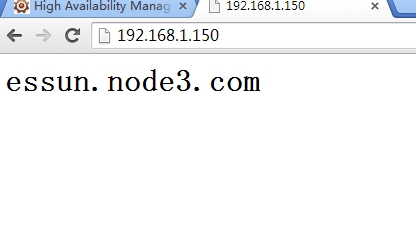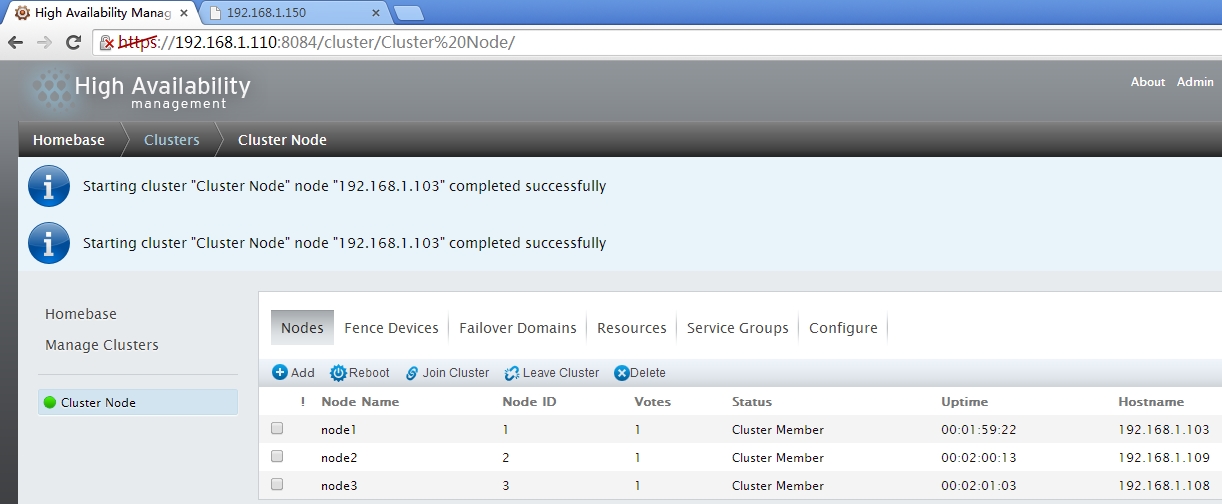Linux High Availabi RHCS
-----本文大纲
简介
术语
环境配置
实现过程
命令行管理工具
-------------
一、简介
RHCS即 RedHat Cluster Suite ,中文意思即红帽集群套件。红帽集群套件(RedHat Cluter Suite, RHCS)是一套综合的软件组件,可以通过在部署时采用不同的配置,以满足你的对高可用性,负载均衡,可扩展性,文件共享和节约成本的需要。对于需要最大 正常运行时间的应用来说,带有红帽集群套件(Red Hat Cluster Suite)的红帽企业 Linux 集群是最佳的选择。红帽集群套件专为红帽企业 Linux 量身设计,它提供有如下两种不同类型的集群: 1、应用/服务故障切换-通过创建n个节点的服务器集群来实现关键应用和服务的故障切换 2、IP 负载均衡-对一群服务器上收到的 IP 网络请求进行负载均衡利用红帽集群套件,可以以高可用性配置来部署应用,从而使其总是处于运行状态-这赋予了企业向外扩展(scale-out)Linux 部署的能力。对于网络文件系统(NFS)、Samba 和Apache 等大量应用的开源应用来说,红帽集群套件提供了一个随时可用的全面故障切换解决方案。
二、术语
-
分布式集群管理器(CMAN)
- 锁管理(DLM)
- 配置文件管理(CCS)
- 栅设备(FENCE)
- 高可用服务管理器
- 集群配置管理工具
- Redhat GFS
三、环境配置
| 系统 | 角色 | ip地址 | 安装包 |
| Centos6.5 x86_64 | 管理集群节点端 | 192.168.1.110 | luci |
| Centos6.5 x86_64 | web节点端(node1) | 192.168.1.103 | ricci |
| Centos6.5 x86_64 | web节点端(node2) | 192.168.1.109 | ricci |
| Centos6.5 x86_64 | web节点端(node3) | 192.168.1.108 | ricci |
四、实现过程
前提
ssh互信
注:如果yum源中有epel源要禁用,这是因为,此套件为redhat官方只认可自己发行的版本,如果不是认可的版本,可能将无法启动服务
-
管理集群节点端
[root@essun ~]# yum install -y luci [root@essun ~]# service luci start Adding following auto-detected host IDs (IP addresses/domain names), corresponding to `essun.node4.com‘ address, to the configuration of self-managed certificate `/var/lib/luci/etc/cacert.config‘ (you can change them by editing `/var/lib/luci/etc/cacert.config‘, removing the generated certificate `/var/lib/luci/certs/host.pem‘ and restarting luci): (none suitable found, you can still do it manually as mentioned above) Generating a 2048 bit RSA private key writing new private key to ‘/var/lib/luci/certs/host.pem‘ Starting saslauthd: [ OK ] Start luci... [ OK ] Point your web browser to https://essun.node4.com:8084 (or equivalent) to access luci [root@essun ~]# ss -tnpl |grep 8084 LISTEN 0 5 *:8084 *:* users:(("python",2920,5)) [root@essun ~]#
而节点间要安装ricci,并且要为各节点上的ricci用户创建一个密码,以便集群服务管理各节点,为每一个节点提供一个测试页面(此处以一个节点为例,其它两个节点安装方式一样)
[root@essun .ssh]# yum install ricci -y [root@essun ~]# service ricci start Starting oddjobd: [ OK ] generating SSL certificates... done Generating NSS database... done Starting ricci: [ OK ] [root@essun ~]# ss -tnlp |grep ricci LISTEN 0 5 :::11111 :::* users:(("ricci",2241,3)) #ricci默认监听于11111端口 [root@essun .ssh]# echo "ricci" |passwd --stdin ricci Changing password for user ricci. passwd: all authentication tokens updated successfully. #此处以ricci为密码 [root@essun html]# echo "<h1>`hostname`</h1>" >index.html [root@essun html]# service httpd start Starting httpd: [ OK ]
-
打开web界面就可以配置了
输入正确的用户及密码就可登录了,如果是root登录会有警告提示信息
-
这时就可以使用Manager Clusters管理集群了
-
创建一个集群
-
创建完成后
标签说明
-
定义故障转移域
-
定义故障转移域的优先级,当节点重新上线后,资源是否切换
-
添加后的状态
-
可以选择的资源类型
-
添加一个ip地址
- 提交后生成的一条记录
-
将此资源添加到组中(也可以在service group定义资源)
-
还可以添加资源
-
将己经定义的资源添加到组中(之前己经定义过的ip地址)
-
添加一个web服务
定义完成后就可以提交了,如果此资源想撤销,可以点击右上角remove即可
-
提交后的组资源
- 重启组资源(Restart)
- 当前的状态己经显示运行于节点node1上
访问测试一下,己经运行于node1上
- 模拟故障转移
-
查看资源是否转移,可以查看service group,也可能通过网页测试
-
服务己经切换到node3上,访问一下网页看一下效果
-
资源的确己经切换了,让node1重新上线后,资源是不会切换回到node1上的,因为在定义节时己经设置了no failback
五、命令行管理工具
1、clustat
clustat 显示集群状态。它为您提供成员信息、仲裁查看、所有高可用性服务的状态,并给出运行 clustat 命令的节点(本地)
命令参数
[root@essun html]# clustat --help clustat: invalid option -- ‘-‘ usage: clustat <options> -i <interval> Refresh every <interval> seconds. May not be used with -x. -I Display local node ID and exit -m <member> Display status of <member> and exit -s <service> Display status of <service> and exit -v Display version and exit -x Dump information as XML -Q Return 0 if quorate, 1 if not (no output) -f Enable fast clustat reports -l Use long format for services #查看节点状态信息 [root@essun html]# clustat -l Cluster Status for Cluster Node @ Wed May 7 11:32:55 2014 Member Status: Quorate Member Name ID Status ------ ---- ---- ------ node1 1 Online, Local, rgmanager node2 2 Online node3 3 Online Service Information ------- ----------- Service Name : service:webservice Current State : started (112) Flags : none (0) Owner : node1 Last Owner : none Last Transition : Wed May 7 10:06:48 2014
2、clusvcadm
您可以使用 clusvcadm 命令管理 HA 服务。使用它您可以执行以下操作:
重启服务
命令参数
[root@essun html]# clusvcadm usage: clusvcadm [command] Resource Group Control Commands: -v Display version and exit -d <group> Disable <group>. This stops a group until an administrator enables it again, the cluster loses and regains quorum, or an administrator-defined event script explicitly enables it again. -e <group> Enable <group> -e <group> -F Enable <group> according to failover domain rules (deprecated; always the case when using central processing) -e <group> -m <member> Enable <group> on <member> -r <group> -m <member> Relocate <group> [to <member>] Stops a group and starts it on another cluster member. -M <group> -m <member> Migrate <group> to <member> (e.g. for live migration of VMs) -q Quiet operation -R <group> Restart a group in place. -s <group> Stop <group>. This temporarily stops a group. After the next group or or cluster member transition, the group will be restarted (if possible). -Z <group> Freeze resource group. This prevents transitions and status checks, and is useful if an administrator needs to administer part of a service without stopping the whole service. -U <group> Unfreeze (thaw) resource group. Restores a group to normal operation. -c <group> Convalesce (repair, fix) resource group. Attempts to start failed, non-critical resources within a resource group. Resource Group Locking (for cluster Shutdown / Debugging): -l Lock local resource group managers. This prevents resource groups from starting. -S Show lock state -u Unlock resource group managers. This allows resource groups to start. #资源迁移 [root@essun html]# clusvcadm -r webservice -m node1 Trying to relocate service:webservice to node1...Success service:webservice is now running on node1 [root@essun html]# curl http://192.168.1.150 <h1>essun.node1.com</h1>
3、cman_tool
cman_tool是一种用来管理CMAN集群管理子系统的工具集,cman_tool可以用来添加集群节点,杀死另一个集群节点或改变预期集群的选票的价值。
注意:cman_tool发出的命令会影响你的集群中的所有节点。
命令参数
[root@essun html]# cman_tool -h Usage: cman_tool <join|leave|kill|expected|votes|version|wait|status|nodes|services|debug> [options] Options: -h Print this help, then exit -V Print program version information, then exit -d Enable debug output join Cluster & node information is taken from configuration modules. These switches are provided to allow those values to be overridden. Use them with extreme care. -m <addr> Multicast address to use -v <votes> Number of votes this node has -e <votes> Number of expected votes for the cluster -p <port> UDP port number for cman communications -n <nodename> The name of this node (defaults to hostname) -c <clustername> The name of the cluster to join -N <id> Node id -C <module> Config file reader (default: xmlconfig) -w Wait until node has joined a cluster -q Wait until the cluster is quorate -t Maximum time (in seconds) to wait -k <file> Private key file for Corosync communications -P Don‘t set corosync to realtime priority -X Use internal cman defaults for configuration -A Don‘t load openais services -D<fail|warn|none> What to do about the config. Default (without -D) is to validate the config. with -D no validation will be done. -Dwarn will print errors but allow the operation to continue. -z Disable stderr debugging output. wait Wait until the node is a member of a cluster -q Wait until the cluster is quorate -t Maximum time (in seconds) to wait leave -w If cluster is in transition, wait and keep trying -t Maximum time (in seconds) to wait remove Tell other nodes to ajust quorum downwards if necessary force Leave even if cluster subsystems are active kill -n <nodename> The name of the node to kill (can specify multiple times) expected -e <votes> New number of expected votes for the cluster votes -v <votes> New number of votes for this node status Show local record of cluster status nodes Show local record of cluster nodes -a Also show node address(es) -n <nodename> Only show information for specific node -F <format> Specify output format (see man page) services Show local record of cluster services version -r Reload cluster.conf and update config version. -D <fail,warn,none> What to do about the config. Default (without -D) is to validate the config. with -D no validation will be done. -Dwarn will print errors but allow the operation to continue -S Don‘t run ccs_sync to distribute cluster.conf (if appropriate) #查看节点属性 [root@essun html]# cman_tool status Version: 6.2.0 Config Version: 6 Cluster Name: Cluster Node Cluster Id: 26887 Cluster Member: Yes Cluster Generation: 36 Membership state: Cluster-Member Nodes: 3 Expected votes: 3 Total votes: 3 Node votes: 1 Quorum: 2 Active subsystems: 9 Flags: Ports Bound: 0 11 177 Node name: node1 Node ID: 1 Multicast addresses: 239.192.105.112 Node addresses: 192.168.1.103
郑重声明:本站内容如果来自互联网及其他传播媒体,其版权均属原媒体及文章作者所有。转载目的在于传递更多信息及用于网络分享,并不代表本站赞同其观点和对其真实性负责,也不构成任何其他建议。



